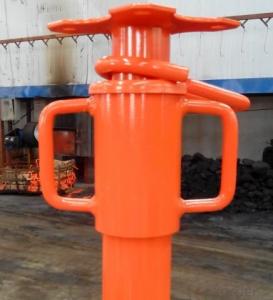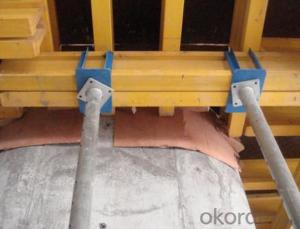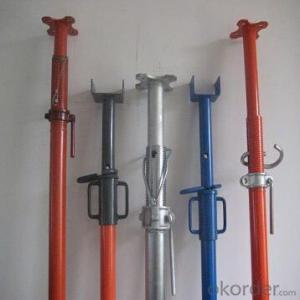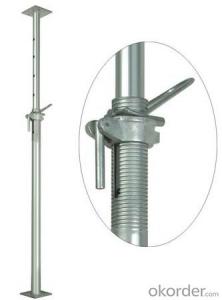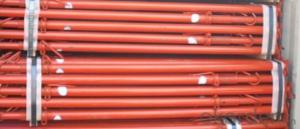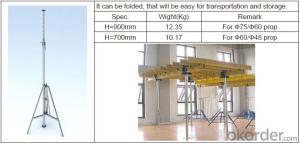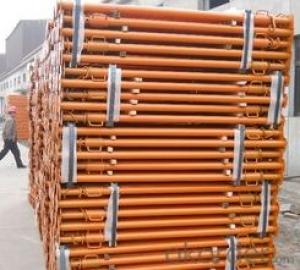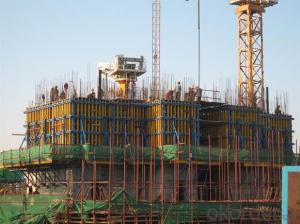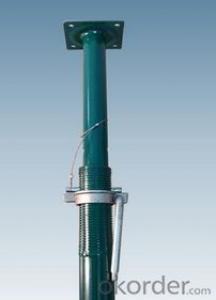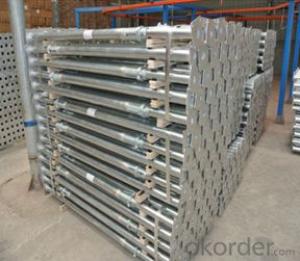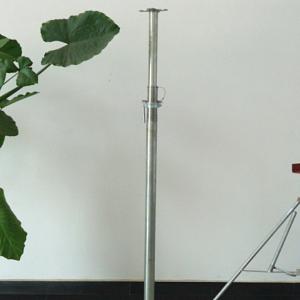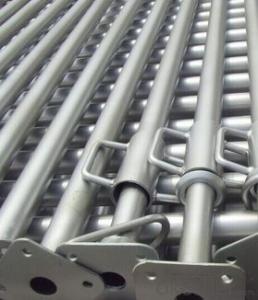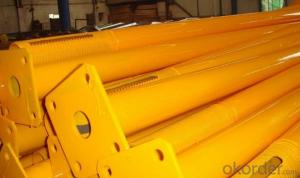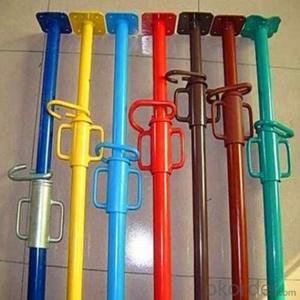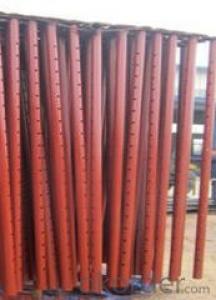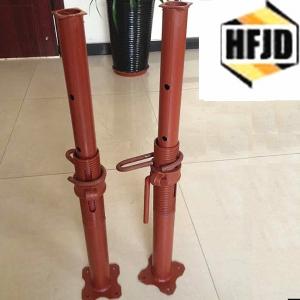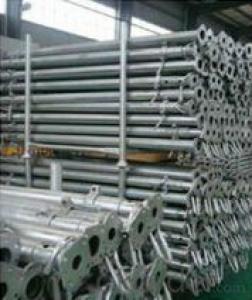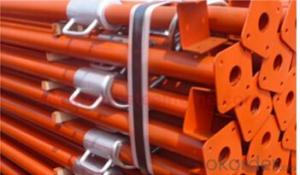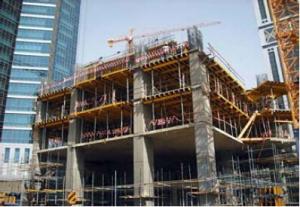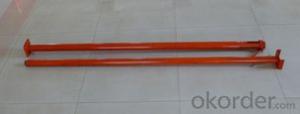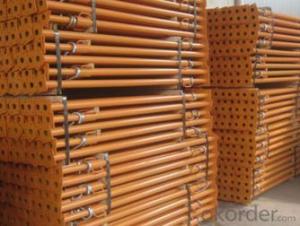Galvanized Scaffolding Steel Props
- Loading Port:
- China Main Port
- Payment Terms:
- TT OR LC
- Min Order Qty:
- -
- Supply Capability:
- -
OKorder Service Pledge
OKorder Financial Service
You Might Also Like
Quick Details
| Type: | Scaffolding Part Type: | Surface finish: | |||
| Raw material: |
Packaging & Delivery
| Packaging Detail: | 50PCS/PALLET |
| Delivery Detail: | 25 DAYS |
Specifications
Galvanized Scaffolding Steel Props
1)Reliable manufacturer 13 years
2)ISO9001:2000 certified
3)fast delivery time
Light Type Props(Spain Style)
Available in Power Coated finish.We can also make Painted(Electro Plated,
Hot Gal. upon customers’s request).
Item No. | Adjustable Length | Tube Size | Weight(kg) |
dx140SL | 0.8-1.4M | Out Tube: 48*1.8mm; | 4.8 |
dx300SL | 1.6-3.0M | 7.05 | |
dx350SL | 2-3.5M | 9 | |
dx400SL | 2.2-4.0M | 9.62 |
Prop adjustable length :1600-3000mm.1700-3100mm,1800-3200mm,2000-3500mm,2000-3600mm 2200-4000mm
Diameter of pipe: 48/40mm,56/48mm,60/48mm,76/60mm
Thickness of pipe:1.5mm-5.0mm
Top/base plate:110*110*4mm,120*120*4mm,150*150*6mm etc.
Surface treatment:Powder coated. Painting. Galvanzied ,Hot Dipped Galvanzied.
Package:50pcs/pallet, 1500pcs/20gp for square plate 1750pcs/250gp for flower plate 1000-2500pcs in bulk of container
Raw material:Q215,Q235,Q275,Q345
Delivery time: 14days &30days for big quantity
Payment term:T/T or L/C
- Q: Can steel props be used in shopping center construction?
- Yes, steel props can be used in shopping center construction. Steel props provide strong and reliable support for structures during the construction process. They are commonly used to support temporary loads or to provide temporary bracing during construction work. Steel props offer adjustable height options and can easily be installed and dismantled, making them a versatile choice for various construction projects, including shopping center construction.
- Q: Can a steel prop be adjusted in height?
- Yes, a steel prop can be adjusted in height. Steel props are commonly used in construction and are designed with an adjustable mechanism that allows for easy height modification to suit various building needs.
- Q: Can steel props be used for temporary support during beam installation?
- Yes, steel props can be used for temporary support during beam installation. Steel props are adjustable supports that are commonly used in construction to provide temporary support to beams, slabs, walls, and other structural elements. They are designed to be strong and stable, capable of supporting heavy loads. Steel props can be easily adjusted to the desired height and are suitable for various construction applications, including beam installation. Their versatility and load-bearing capacity make them an ideal choice for temporary support during beam installation.
- Q: What is the steel plate support
- If it is embedded - embedded iron.If the structure is used as steel stairs - metal structure item set
- Q: Are steel props suitable for supporting temporary grandstands or bleachers at sporting events?
- Absolutely, steel props are a great choice for providing support to temporary grandstands or bleachers during sporting events. Steel, being an incredibly robust and long-lasting material, can effortlessly withstand the immense weight and pressure exerted by numerous spectators occupying the grandstands or bleachers. Its stability guarantees the safety of the audience throughout the event. Widely utilized in construction and engineering ventures, steel props are specifically engineered to bear substantial loads. Additionally, they can be conveniently adjusted and installed to cater to the precise demands of temporary grandstands or bleachers. Consequently, they serve as an optimal selection for bolstering these structures at sporting events.
- Q: Can steel props be used for supporting temporary elevated platforms?
- Yes, steel props can be used for supporting temporary elevated platforms. Steel props, also known as adjustable steel props or acrow props, are commonly used in construction and temporary structures to provide support and stability. They are designed to be easily adjustable in height, making them ideal for supporting platforms at different elevations. Steel props are strong and durable, capable of withstanding heavy loads and providing a secure base for elevated platforms. Additionally, their versatility and ease of use make them a popular choice for temporary structures in various industries.
- Q: Can steel props be used in earthquake-prone areas?
- Yes, steel props can be used in earthquake-prone areas. Steel is a strong and durable material that has excellent resistance to seismic forces. Steel props are commonly used in construction projects, including in earthquake-prone areas, to provide temporary support to structures during construction or renovation work. These props are designed to withstand heavy loads and vibrations, making them suitable for use in areas prone to earthquakes. Additionally, steel props can be easily adjusted and installed, making them versatile and adaptable to different construction needs. However, it is crucial to ensure that the steel props used in earthquake-prone areas are designed and installed according to local building codes and regulations to ensure maximum safety and stability.
- Q: Can steel props be used in the construction of temporary road barriers?
- Temporary road barriers can indeed incorporate steel props in their construction. Steel props find frequent application in construction endeavors, serving as reliable support for scaffolding and formworks. Their purpose lies in furnishing stability and robustness, rendering them appropriate for diverse uses, including temporary road barriers. The adaptability of steel props permits effortless alteration of heights and firm grounding, thereby guaranteeing the road barriers' longevity and steadfastness. Furthermore, steel props boast commendable load-bearing capabilities, qualifying them to endure the influence of vehicles and other external pressures.
- Q: Are steel props suitable for supporting temporary agricultural structures?
- Yes, steel props are suitable for supporting temporary agricultural structures. Steel props are known for their strength and durability, making them an ideal choice for supporting structures in agricultural settings. They can provide the necessary stability and support required to withstand various weather conditions and heavy loads. Additionally, steel props are adjustable, allowing for easy customization and adaptation to different heights and sizes of agricultural structures. They are also resistant to pests, rot, and decay, ensuring a longer lifespan compared to other materials. Overall, steel props are a reliable and effective solution for supporting temporary agricultural structures.
- Q: What are the disadvantages of using steel props?
- There are a few disadvantages of using steel props in construction projects. Firstly, steel props can be quite heavy and bulky, which can make them difficult to transport and handle on-site. This can lead to increased labor costs and time spent setting up and dismantling the props. Secondly, steel props can have limited adjustability. While they can be extended or shortened to a certain extent, they may not be as flexible as other types of support systems. This can be a drawback when working on projects that require precise adjustments or in situations where the ground may not be level. Another disadvantage is the potential for corrosion. Steel props are susceptible to rust and deterioration when exposed to moisture or harsh environmental conditions. This can reduce their lifespan and require regular maintenance or replacement, adding to the overall project costs. Additionally, steel props can create noise and vibrations during construction activities. This can be a nuisance to nearby residents or workers and may require additional measures to mitigate these disturbances. Lastly, steel props can be more expensive compared to other temporary support systems. Depending on the project requirements and duration, alternative options such as timber or aluminum props may offer a more cost-effective solution. Overall, while steel props have their advantages in terms of strength and load-bearing capacity, it is important to consider these disadvantages when choosing the appropriate support system for a construction project.
Send your message to us
Galvanized Scaffolding Steel Props
- Loading Port:
- China Main Port
- Payment Terms:
- TT OR LC
- Min Order Qty:
- -
- Supply Capability:
- -
OKorder Service Pledge
OKorder Financial Service
Similar products
Hot products
Hot Searches
Related keywords
